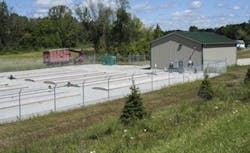Residents of Christiansburg, Ohio, knew they had problems with their onsite wastewater systems. System failures and odors were common, particularly during or after significant rainfall. In 2012, the Ohio Environmental Protection Agency (EPA) detected high levels of bacteria in the stream that runs along the west side of the village, prompting community leaders to seek cost-effective wastewater management solutions.
Before the EPA could take regulatory action, community leaders hired an engineer to evaluate their options and estimate costs. With the population of Christiansburg at little more than 500 people and the village’s median household income well below the national average, the village council knew it was imperative that upfront capital outlays and operation and maintenance costs be kept low.
Solution
After reviewing the cost comparisons in the engineer’s report, council members realized that an Orenco effluent sewer followed by AdvanTex treatment was the most economical option. It offered the ease of operation that would allow the village to affordably manage its own facility.
Constructing a new wastewater treatment plant required that Christiansburg obtain an National Pollutant Discharge Elimination System (NPDES) permit through the Ohio EPA, which had mandated that the discharge meet a strict ammonia limit of less than 1 mg/L (summer). The AdvanTex treatment system the council chose would ensure the village could meet this limit. In addition, the system offered low biosolids management requirements, low energy consumption and low maintenance requirements, as well as the ability to successfully treat highly variable flows.
Construction began in January 2014. Every septic tank in the village was decommissioned and new watertight tanks were installed at each residence and business. In an effluent sewer system, the onsite primary tankage provides passive anaerobic digestion that reduces the organic and solids load to the wastewater treatment plant. Primary-treated effluent from the tank’s “clear zone” is pumped through small-diameter (2- to 4-in.) force mains to the treatment facility.
AdvanTex treatment systems use an attached-growth treatment process, along with fractional horsepower fans to draw air through the media and provide sufficient oxygen for aerobic digestion. Low-horsepower, high-head turbine pumps operate intermittently with sophisticated controls that automatically adjust recirculation ratios and pump runtimes based on daily flows. The energy required for aerating and distributing the wastewater onto the media is considerably less than for activated sludge facilities commonly used by larger cities.
“This was my first time working with Orenco, and it’s been a success without a doubt,” said Randy VanTilburg, P.E., who designed the Christiansburg project. “I am actively seeking new projects we can work together on in the future.”
Results
With a constructed cost of just $16,358 per equivalent dwelling unit, the Orenco effluent sewer and AdvanTex treatment plant at Christiansburg are highly affordable compared to other wastewater technologies. Effluent sewers have proven to be cost-effective largely because they use small-diameter, shallowly buried mainlines along variable grades to convey wastewater to a treatment facility, rather than using large-diameter, deeply excavated conveyance mains laid at a constant slope, as in a gravity collection system.
An additional financial benefit of effluent sewers is that they provide years of anaerobic digestion. Textbook evaluations indicate that typically 80% of biosolids in watertight onsite tanks are digested on an annual basis. This lower organic and solids load provides a substantial reduction in power costs at the treatment facility. In addition to saving on operation and maintenance expenses, an effluent sewer also offers a reduced organic load, thus decreasing the size and capital cost of the treatment plant.
“We maintain another plant for a community of a similar size that chose a different wastewater technology [a package activated sludge facility], and that plant uses ten times as much electricity per day as the Christiansburg plant does,” said Monte J. Edwards II, M.S., a 22-year veteran of the environmental engineering field and a principal partner with Analytical Associates, which was contracted by the Village of Christiansburg to operate and maintain its new treatment facility.
Other villages are taking note of Christiansburg’s new sewer system and wastewater facility, sending representatives to tour the community and ask questions as they research the possibility of building their own wastewater plant.
“These smaller communities would not be able to afford a sewer system without having Orenco effluent sewers and AdvanTex treatment as an option,” said Edwards.
Wesley Anderson, P.E., is community systems engineer for Orenco. Anderson can be reached at [email protected] or 541.459.4449, ext. 449.


